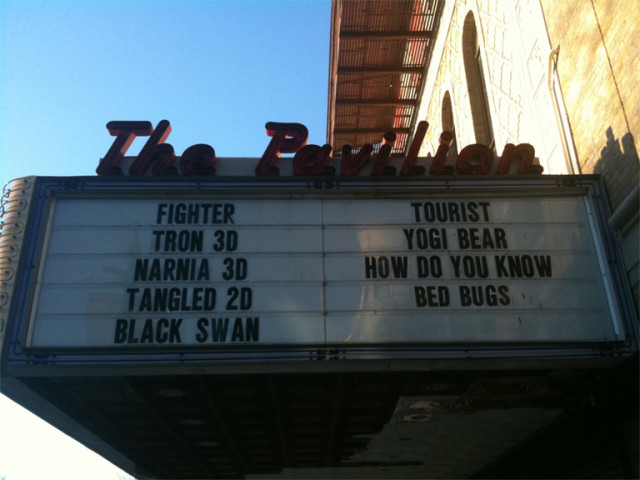

Brooke Borel, a science reporter living in Park Slope, knows a thing or two about bed bugs. The “Bed Bug Queen,” as Business Insider called her, Borel has had bed bugs three times in New York City, and those experiences led her to write her first book, Infested: How the Bed Bug Infiltrated Our Bedrooms and Took Over the World, which came out last year. In their review, Library Journal said it’s “For anyone who wants to replace their fear of bed bugs with knowledge.”
Since it’s now the fall, the time a lot of people move in and out of apartments, hunt for sidewalk furniture and start wearing bed-bug attracting coats everywhere, we spoke to Brooke to hear more about what she learned going deep on New York’s most feared pest.
Let’s start at the beginning. How did you get so fascinated by bed bugs?
The first time I had bed bugs was 2004 in my Hell’s Kitchen apartment. This was before they were in the news very much — the resurgence [which started in the early 2000s] was already happening but the media frenzy wasn’t quite there yet so it took me a while to figure out what was going on. I happened to be very allergic to them, so it was a traumatic thing.
I thought I’d never run into them again, but then I got them twice in the same summer four years later in Greenpoint. Well, I count it as two times. The first was when my boyfriend — who’s now my husband, but we weren’t yet living together — got them at his apartment in Greenpoint. I got bitten there and because I’m so allergic, I knew what it was. We called an exterminator and I was right. A month later I got them in my apartment. We still don’t totally agree whether he gave them to me or if I got them from a roommate who had just moved some Craigslist furniture into the apartment.
And you’ll never know.
Right, we’ll never know.
__________

So how did it become a book?
The first time I got them I wasn’t working at a journalist. But the second time, in 2009, I was, specifically a science journalist. I was writing quite a bit for Popular Science and other magazines and I started writing small, more newsy pieces about bed bugs and their evolution to thwart our modern pesticides. While researching those articles, I realized there was so much more to the story and I found it really fascinating — that’s how the book idea came about.
And that’s part of your area of focus, right? How bed bugs have evolved. What’s one of the most surprising things you learned?
When I was working on those shorter news articles, I very distinctly remember interviewing this woman named Dini Miller who’s an entomologist at Virginia Tech who works specifically with bed bugs and other pest insects. She’s an extension researcher, meaning she does a lot of community outreach. She’d been so inundated with phone calls from the public trying to figure out how to get rid of bed bugs that the only time she could talk to me was while she was at work on a Saturday.
Anyway, I asked something along the lines of “it’s so weird that we’re suddenly starting to have such a problem with bed bugs, why is that happening?” and she said, “That’s not actually weird. The weird part is that there was every a period of time when we weren’t having a problem with bed bugs because they actually extend far back into human history, thousands of years.”
There’s since been research suggesting that bed bugs even extend back 250,000 years. (That’s not a definite thing, but a scientific suggestion. More research is needed.) So we’ve actually had this really long history with bed bugs — it was really just around World War II and the advent of DDT and other modern synthetic pesticides that we were able to knock them back. So it’s not really that surprising that they have resurged — it’s more surprising that it took them so long.
Can you explain that a bit more — the drop was because of pesticides?
There was sort of a push back [meaning they weren’t as prevalent] on bed bugs after the introduction of DDT [which was banned in 1972 in the US] and other synthetic pesticides because it was the first time we had such effective pesticides. DDT leaves a residue on surfaces for a very long period of time — like, months and months — and we’d never had anything like that previously. Bed bugs hide in cracks and crevices around the bed and come out at night to feed [so if a room was treated with DDT], they’d walk through that residue and die. The other tactics — and there were many — we’d previously used [to combat bed bugs] didn’t last the same way so it was harder to get rid of them.
Of course DDT had a lot of environmental problems, which is also part of the story of DDT, but we were able to knock their numbers down considerably for several decades, at least in the US and parts of Europe, Asia and Australia. Other parts of the globe didn’t necessarily see that same dip. But … bed bugs started building resistance to the DDT very soon after the start of our use of it — that happens, it’s just evolution.
___________

Every few years, there seems to be a rash of hyperbolic headlines about how bed bugs are evolving, like a few years ago everyone was worried about bed bugs on some of the subway lines — there was a little media frenzy about whether they’d evolved to feed on plastic and things like that. Is this something we actually need to worry about?
Well, yes, bed bugs are evolving because everything is always evolving, especially when you have something like insects that reproduce and make new generations very quickly.
Bed bugs evolve two different ways that make it hard to kill them, especially with pesticides. They develop these mutations that make it so the pesticide can’t knock out their neurological system as easily, and they also have these mutations that give them a higher tolerance to pesticides. And then there’s some evidence that some bed bugs might be growing thicker exoskeletons, which might help slow down pesticides getting inside of them. So there’s scientific evidence for all of that. But as far as evolving to better attack people on the subway? That’s not true.
The stories about the subway, from what I can tell, are more about where the conductor is, and it was probably something. Bed bugs feed on humans so they could potentially be anywhere where humans are, but they’re more likely to be in a place where someone is either sleeping or sitting for long periods of time. They don’t jump, they don’t fly. They hang out close to where they eat. It’s like the laziest form of hunting possible. They wait for you to come to bed, they come out of their little hiding place, bite you then go back. Or, on the couch, or someone driving a subway car who has accidentally brought them from home. The actual seats of the subway car aren’t the most likely place for them to an infestation.
Ok, so how in the hell do you get rid of these things? There are so many options — the freezing method, chemical pesticide application … one friend recommended sprinkling diatomaceous earth as a less toxic option. But when I had mine, my attitude went from — and I’m going to sound like a Brooklyn cliche — someone who tries to buy organic and use the humane mouse trap to “Bring the fucking chemicals, bomb the hell out of this place, I don’t care what you have to do, just nuke ‘em all!” What info should people know as they’re thinking about how to treat them?
Well, this is also a cliche, but it’s a phrase that a lot of pest control and entomologist people usually use: “There’s no single silver bullet.”
Usually, a multi-prong attack is what’s going to work. It’s part getting rid of clutter, not because clutter attracts bed bugs but because clutter gives them more places to hide. It’s a matter of doing your laundry and washing your sheets in hot water and drying on high heat because high temperatures kill bed bugs and their eggs. Sometimes, steam treatments and/or freezing treatments can work, too, though the science behind whether freezing really works that well is a little mixed. Products like diatomaceous earth can also certainly help — it’s basically a dust you sprinkle down made from crushed up diatoms, which are more or less fossilized algae. When the insect walks through it, it slices them up and they die. People also use it as flea control — I used it in my kitchen for ants last summer. Also: vacuuming, and probably some pesticides, too.
You can also get a professional to do a heat treatment. You have to remove anything that would be flammable at really high temperatures and then they heat up your home to kill the bed bugs. It can work very well if it’s done right, but it’s very expensive — it can cost thousands of dollars — and not great for apartments; it’s just harder to heat up an entire building and if you’re only treating one unit and another has bed bugs, they can very easily just come back to the treated unit.
Side note: Some people have tried to do heat treatments on their own with space heaters or something similar, and that’s not a good idea.
__________
Yeah, that sounds like a horrible idea. Is it safe to say that if you do have bed bugs, it’s best to call a professional?
Personally, if I thought I had bed bugs again — and I would be pretty sure since I’m so allergic and be able to catch it early before it became a huge infestation — instead of just calling an exterminator immediately I might go ahead and try and do all of my laundry, and then do a thorough sweep of my room, vacuuming really well, and just try and see if I can get them that way. Then, I’d check and watch for more bites. That won’t work for people who don’t get bites or don’t know what they’re looking for. But otherwise there are so many different treatments, it really depends…
What about the bed bug sniffing dogs a lot of services offer?
The dogs I think are a little hit or miss. There’s research showing that they can work pretty well but it’s been in pretty controlled lab settings. I think that the reality will really depend on how well the dog is trained … I think it’s relatively easy to get false positives. I would say if you get a dog to come and there’s a positive ID, I’d want visual proof that yes, there are bed bugs. Remember: you can see them. I say this just because the dogs are expensive and the treatments are expensive, so I would want more proof.
Ok, here’s a fun one. Historically, bed bugs are one of the few things that can truly frighten a New Yorker. I have a list of typical New York behaviors I want to ask you about and whether you’ve changed them based on your research and experience.
First, do you still pick up furniture off the street?
I, personally, don’t. However, I’m not really in the market for furniture right now. I would say if you see a piece on the sidewalk you really want — bed bugs are visible to the human eye, so you can take a look. The youngest ones are pretty small so they’re not that easy to see but they are visible, and so are the eggs. Bed bugs like to hide in little cracks and crevices. If we’re talking about a table that’s very smooth and doesn’t have that many joints involved, or something that likely wasn’t in someone’s bedroom, like a kitchen table, that might be fine. If it’s something like a mattress or a couch with a lot of fabric — a lot of places for them to hide — or a piece of wicker furniture — something with a lot of little holes and cracks — I’d probably just avoid that.
What about sitting on the wooden subway benches?
I don’t think it’s very likely. Think of it this way: the hot spot for bed bugs are where people live, especially huge apartment buildings with many, many people living there, especially if the landlord or whoever’s in charge isn’t getting things under control when people have bed bugs. Anytime there’s a shared, public space, those are little sparks jumping off from those hot spots. So yes, someone who has a bed bug infestation at home might accidentally have them hanging on their stuff — maybe in their bag or something like that. It’s possible they they then sit on a subway bench and maybe one could come off and get on you, but it’s not very likely. Bed bugs are probably not setting up shop on a subway bench unless someone is regularly sleeping there and also happens to have bed bugs and has been there for a very long time. It’s not hugely likely that if you sit on the bench, you’re going to pick them up.
When I got them, there was about a week that I wouldn’t sit and then eventually I thought, “I’m tired, I’m going to sit.”
Yeah, I think it’s fine, I sit.
___________

What about movie theaters? You live in Park Slope, you know the rumors about The Pavilion (RIP), will you still go to movie theaters?
Oh yeah, I go all the time. You see some companies selling these ridiculous seat covers — those are not going to help you.
Ha, really? I haven’t seen those.
I don’t even know if they’re still for sale but I’ve seen the concept out there.
It’s a disposable seat cover that you bring to use at the theater?
I have a story in my book actually, an anecdote that a friend of a friend told me. His wife was very afraid of bed bugs and she actually made them both wear tyvek suits to the movies. After that, they decided it wasn’t worth it and never went again. Doing something like that is not probably going to help you much.
My recommendation for the movies is — and this is actually just a recommendation in general — if you’re going somewhere that you’re worried may have bed bugs, carry less stuff. Don’t go to the movies with a ton of shopping bags, plus your backpack, plus your purse, plus a giant coat … whatever. The more stuff you have, if there are bed bugs there, the more likely they might be able to get into your stuff. And if you’re really that worried, throw your stuff in the laundry when you get home.
Ok so it seems like the aforementioned advice applies to almost anything — park benches, stoop sales, clothing swaps. But what about hotels?
After I turned in the first draft of the book I actually got bed bugs at a hotel in Chicago, which is actually kind of funny. It ended up in the epilogue of the book. So even if you do the things I’m about to tell you, you still could end up with bed bugs in your room. The most likely place for bed bugs to be in a hotel room is around the bed or the headboard, so I don’t put my stuff on the furniture, specifically on the bed. If I have time, I’ll turn up the sheets and do a quick check around the mattress seams. If I can, I’ll check around the headboard. One time I accidentally took a headboard off the wall in a hotel and it was too heavy for me to lift back up so I stopped messing around with that too much.
Some people put their luggage in the bathroom because that’s the least likely place for them to be. I don’t do that usually. If they have one of those luggage racks, I might use that after giving it a once-over. The time I got them though, I woke up very early in the morning and had bites and we called the management and they came up and they found them in the bed skirt. So you could spend hours inspecting a room and not find them, but still have them. I think keeping your clothes and luggage away from the bed then doing all your laundry when you come home is a good way to deal with it.
Right. People don’t realize how simple it is to do your laundry as soon as you get home. Before we wrap up, is there anything else you want to go over?
I think the biggest thing is don’t panic. Yes, it is not fun to get bed bugs. But they’re not known to spread disease and you can get rid of them, and you won’t necessarily have to throw away all of your belongings to get rid of them. It’s not going to be a pleasant experience but it’s not the end of the world. That’s my main message.
See more of Borel’s work on her website, www.brookeborel.com and you can follow her on Twitter at @BrookeBorel.
Editor’s note: This conversation was edited for clarity and continuity.
Erin Scottberg is permanently afraid of bed bugs. Follow her on Twitter at @ErinS.
Leave a Reply



